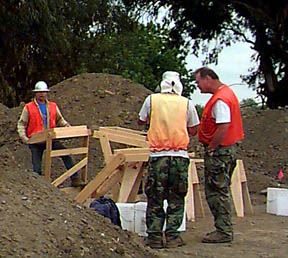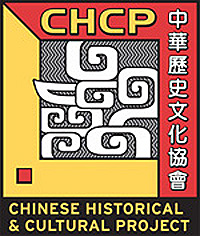|
- Home
- A Woolen Mills Chinatown Arch Jnl-4
A Woolen Mills Chinatown Archaeologist’s Journal -4
By Rebecca Allen, Ph.D.
Week of May 17, 1999: Uncovering a Sense of Place and Space
During the past two weeks, archaeologists focused on understanding the layout of the Woolen Mills Chinatown and its appearance during its occupation. Brick buildings along the main thoroughfare point to a prosperous-looking town, graveled streets tell of a well-maintained neighborhood, and a complex system of redwood and ceramic sewer lines demonstrate cleanliness and modern living. A sense of place was also very important to the inhabitants of the Woolen Mills Chinatown. Visitors to the site can still get a sense of this. Historian Connie Young Yu, after visiting our site, had this to offer:
"The Woolen Mills Chinatown was located adjacent to the Guadalupe River. To the Chinese this was most propitious. Here was a scenic, pastoral location, with good feng shui. It was not surrounded by a fence as was Heinlenville, but was bordered by river banks and fields. Throughout recorded history in China, the river was the symbol of life.
The most important community buildings, a theater and joss house, were in the northwest corner of the Chinatown near the river. This cluster created a southeast-facing square that was most auspicious. Facing south corresponded to a yang symbol, and being by a body of water was also favorable. This location most likely played a role in festivals, such as da jui in the summer when, after the several-days celebration, a lighted procession ended at the river whereupon the lanterns were extinguished.”
Through the use of backhoe, shovel, trowels, and brooms, archaeologists uncovered the streets and buildings that once made up this community. We also carefully draw and document all that we find. Writing notes and observations take up a lot of time in the field, but is critical to our understanding when it comes time to writing the report.
The Trash Has to Go Somewhere
Woolen Mills Chinatown residents (with only one found exception to date) did not dispose of their trash in the backyard. Instead, likely in an effort to keep town tidy and smell-free, trash was thrown over the river bank, beyond the buildings. Here too, though, there was a method of keeping smells down. Tim Kennedy has been excavating the community dump. He told me his observations about how the Chinese threw out their trash:
"Refuse was thrown off the creek bank edge from the back of the Chinatown. The sequence of dumping seems to be this: bucket or basket-loads of broken ceramics, glass, bone, charcoal, etc. were thrown out. Then they were immediately covered with dirt, and then more ash. This was a pretty clean way of getting rid of the trash.
Each episode of trash-throwing seems to have different artifacts, showing different household activities. Some contain more dietary remains, such as animal bone, fish bone, shellfish, and egg shell. Other dumpings have more ceramic and glass. And one contains more metal can fragments. At least one of the dump episodes seems to have been dug as a pit into previous trash, and then covered with topsoil.”

Tim has to keep careful track of the stratigraphy (layers of soil) to be able to distinguish all of the different episodes of dumping (and keep track of all this in his notes!). He uses a shovel and trowel to excavate, and then loads the dirt and artifacts into a wheelbarrow.
“Screeners” take the dirt from the wheel barrow and empty bucketfuls into sifters lined with 1/8-inch window screen. Artifacts bigger than a quarter are pulled out and sorted into different buckets. The dirt in the screen is saved, and will be screened again using a water hose and trowel (this is called “wet screening”) at a later time.
Roasting by the River
One of the historic maps shows two squares with a circle drawn inside each of them located along the river bank. The mapmaker labeled these structures “roasting kettles.” Archaeologists in Los Angeles have uncovered wok ovens, and archaeologists in Folsom have excavated smokers for roasting pigs, but no one we know of had encountered roasting kettles. It may have been the mapmaker’s own peculiar terminology, or it may be something different. We’ve spent the last week discovering and excavating one of these features (the
 other roasting kettle does not seem to survive in the archaeological record). What we have is a circle of bricks, about three feet across, with an opening and platform on one side for cleaning out ashes. A gas pipe (yep, they used gas in the late 1800s) goes into the center of the roasting pit. A separate, small square platform of brick stands about a foot and a half from the main circular pit. Why it’s there we don’t know yet.
other roasting kettle does not seem to survive in the archaeological record). What we have is a circle of bricks, about three feet across, with an opening and platform on one side for cleaning out ashes. A gas pipe (yep, they used gas in the late 1800s) goes into the center of the roasting pit. A separate, small square platform of brick stands about a foot and a half from the main circular pit. Why it’s there we don’t know yet.
After finding this, we began to talk to our historian Connie Yu and archaeologists Mary Maniery and Julia Costello about possible uses for this pit. It may have been used for roasting animals such as pigs. (We’re finding a lot of discarded pig bone nearby.) The feature is too small to roast an entire pig, so perhaps the pig was chopped up and spitted first. A large kettle may have sat on a grill and provided a heating place for ceremonial community stews. During different times of the year, the “roasting kettle” may have been used for different purposes. Have you any ideas? Let us know at info@chcp.org.
What’s Next?
We’re guessing that the week of May 24-28 will be our last week in the field. We’ll be finishing up our hand-excavation of the roasting kettle and other features. A backhoe will also come out to extend our understanding of the sewer lines and their connections. (Everything has to start and leave somewhere.) We’ll also begin our wet-screening. Friends of the Guadalupe River Park and Gardens have offered us use of their lawn, under the trees and near the rose garden. This will be a treat for us, and sure beats the indoor labs we usually work in! – After that, probably a short break. Being in the field for weeks at a time can be tiring, and our friends and family miss us (at least we’d like to think so). Then it’s to the laboratory for processing artifacts, and back to the archives to answer some questions we’ve come up with in the field.
Back to (Journal -1) Week of April 26, 1999: Is Archaeology Glamorous?
Back to (Journal -2) Week of May 3, 1999: Surprises and Ceramics
Back to (Journal -3) Week of May 10, 1999: Field Photos
Forward to (Journal -5) Week of May 24, 1999: Fieldwork Wraps Up
Working with Caltrans are archaeological consultants from the firms of Past Forward, Inc., KEA Environmental, Inc., Foothill Resources, Inc., PAR Environmental, Inc., and the University of California, Chico.

